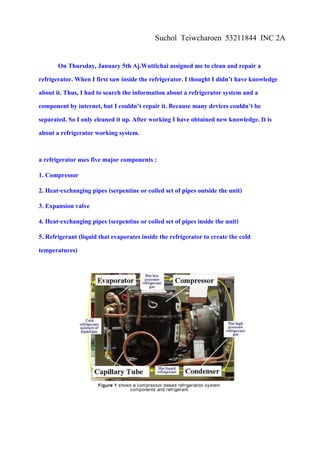Refrigerator
- 1. Suchol Teiwcharoen 53211844 INC 2A On Thursday, January 5th Aj.Wuttichai assigned me to clean and repair a refrigerator. When I first saw inside the refrigerator. I thought I didnât have knowledge about it. Thus, I had to search the information about a refrigerator system and a component by internet, but I couldnât repair it. Because many devices couldnât be separated. So I only cleaned it up. After working I have obtained new knowledge. It is about a refrigerator working system. a refrigerator uses five major components : 1. Compressor 2. Heat-exchanging pipes (serpentine or coiled set of pipes outside the unit) 3. Expansion valve 4. Heat-exchanging pipes (serpentine or coiled set of pipes inside the unit) 5. Refrigerant (liquid that evaporates inside the refrigerator to create the cold temperatures)
- 2. The Refrigeration Cycle 1. The compressor compresses the ammonia gas. The compressed gas heats up as it is pressurized (orange). 2. The coils on the back of the refrigerator let the hot ammonia gas dissipate its heat. The ammonia gas condenses into ammonia liquid (dark blue) at high pressure. 3. The high-pressure ammonia liquid flows through the expansion valve. You can think of the expansion valve as a small hole. On one side of the hole is high-pressure ammonia liquid. On the other side of the hole is a low-pressure area (because the compressor is sucking gas out of that side). 4. The liquid ammonia immediately boils and vaporizes (light blue), its temperature dropping to -27 F. This makes the inside of the refrigerator cold. 5. The cold ammonia gas is sucked up by the compressor, and the cycle repeats.


